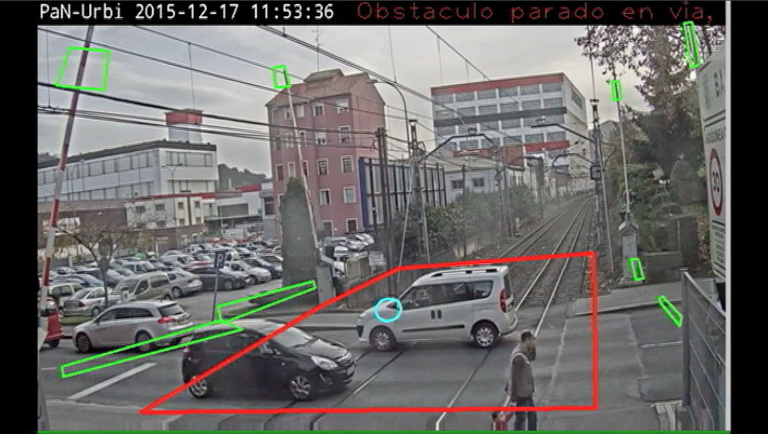Intelligent video surveillance

We are in the command post of the Basque Railway Network in Bilbao. They control all the traffic that passes through the Biscay Railways from here. Through these screens, they also monitor stations and railway crossings.
There are 250 railway crossings in the Autonomous Community of the Basque Country. They are spaces to be shared by trains, vehicles, cyclists and pedestrians, which can be defined as security systems composed of elements such as fixed signals, lights, sounds, automatic barriers... or all at once. The system, called ATP, also automatically stops the train if a red light is found on the way.
Since January of last year, they have been supported here by a system called EyeCrossing: a software that automatically detects dangerous situations through a smart camera installed in the passage.
Assisted by ARITZ LEGARDA. About Visual Line: It processes all the images and knows if the railway crossing is closed or open. Warn if there is a situation where something is dangerous or potentially dangerous. For example, if the railway crossing is closed, i.e. the barriers are down, and a car or person is in the middle, we detect it and give a warning.
This Urbi crossing in Basauri was chosen to test the system. A camera was installed on one of the catenary’s poles, connected to this other device that interprets the images. The images and warnings are transmitted to the command post through a 3G modem.
Assisted by ARITZ LEGARDA. About Visual Line: We talked to the ETS people. We asked them if this technology is applicable to railway crossings, and talking to them, we decided yes, and we ran a pilot test on the Urbi crossing. In fact, many people move from there and many different situations can occur during the day.
THE JAVIER ASTARLO. The STD is: In the end, what we have done is to help the company install cameras – camera and computer – in our facilities and, above all, from the software side, what we have done is to parameterize the alarms that they assumed, to see how the gateway functions and to parameterize the alarms.
Trains do what they're told. The people don't. It is enough to stand next to a railway crossing for 10 minutes to observe the bad behaviors of many pedestrians and drivers.
The EyeCrossing system detects these types of situations and sends different types of warnings depending on their severity. For example, this truck is halfway down the road. The fences are open and the train is still far away, but the vehicle has been paralyzed for more than 10 seconds and could be damaged. An alert has been received at the command post along with the live video signal. In this way, the person in charge can see what is happening and make the necessary decisions.
This time, it is enough to warn the train driver. If the train were closer, or if the barriers began to fall, the emergency button would have to be pressed.
BY JOSÉ ANTONIO PULIDO. About Visual Line: Through this application it is possible to observe, in real time, the alarms that occur in the railway crossing. What we have classified as critical events, that is, the most serious ones, are activated when there is an obstacle standing on the track at the beginning of the lowering of the barriers. At that moment, we send a critical alert.
This technology is known as video content analysis. From a model, the image is analyzed from frame to frame in search of significant changes. Thanks to artificial intelligence, he also learns to distinguish situations.
Assisted by ARITZ LEGARDA. About Visual Line: We define some areas in the image, such as the area that is crossed by trains, people and cars, and we learn what this area is like in a normal situation. When a new image comes, we compare it to that model to find out if there's something that shouldn't be there.
In addition to detecting people and vehicles that obstruct the railway, this intelligent surveillance also serves to ensure that the crossing itself works well: to ensure that trains pass only when the barriers are down, or to see that the barriers are damaged.
THE JAVIER ASTARLO. The STD is: It is very useful from the Manteo side. Because it is a video surveillance camera and, for example, when a car throws a barrier, we have images and it is possible to analyze what has happened.
For nine months, Visual Line technicians have been tweaking the EyeCrossing system to ensure it correctly detected all the situations required by ETS members. In four months, 506 alarms have been generated, 87 of which have been serious and 10 critical.
Assisted by ARITZ LEGARDA. About Visual Line: The system works well, the alerts arrive well at the command post, watch the video and everything has gone very well. The valuation is very positive. After all, we have shown that we can detect dangerous situations.
The main advantage of the system today is that it automatically performs surveillance without having to look at the monitor. The safety system, however, must be activated by the operator.
THE JAVIER ASTARLO. The STD is: Nik uste dut teknologia heldu bat izateko, lotune bat eduki behar du segurtasun-instalazioekin. That, I think, is what is missing.
BegCrossing is already in the sales phase. Visual Line members believe that video content analysis can be a very useful technology to improve safety in critical areas, and they are already working on other products to make intelligent surveillance in dangerous parts of railways, railway stations or mechanical escorts a reality.
Buletina
Bidali zure helbide elektronikoa eta jaso asteroko buletina zure sarrera-ontzian











